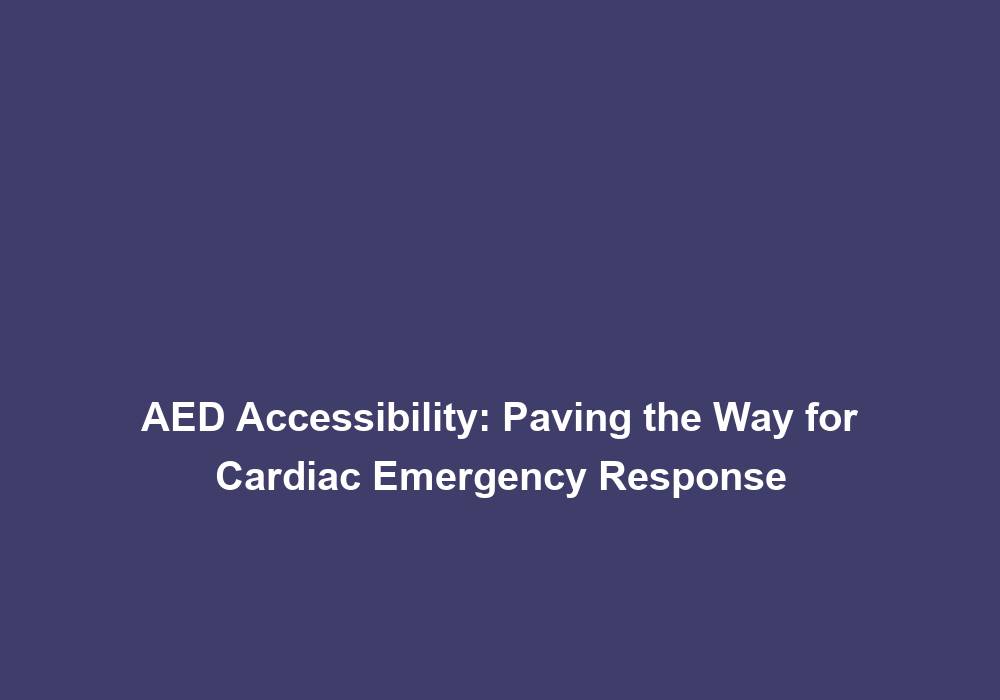AED Accessibility: Paving the Way for Cardiac Emergency Response
Cardiac emergencies, such as sudden cardiac arrests, pose a significant threat to human lives. Quick and effective response is vital in saving lives during such situations. One of the key tools that can make a life-saving difference is an Automated External Defibrillator (AED). However, accessibility to AEDs plays a crucial role in determining their effectiveness in emergency situations. In this article, we will explore the importance of AED accessibility and how it can pave the way for a more efficient cardiac emergency response.
Understanding AEDs and Their Role in Cardiac Emergencies
An Automated External Defibrillator (AED) is a portable electronic device designed to deliver an electric shock to the heart in order to restore a normal cardiac rhythm during a sudden cardiac arrest (SCA). AEDs are often used in conjunction with Cardiopulmonary Resuscitation (CPR) to increase the chances of survival for individuals experiencing a cardiac emergency.
AEDs are designed to be user-friendly, with visual and audio prompts that guide even non-medical personnel through the process of administering defibrillation. These devices analyze the heart’s rhythm and determine if a shock is necessary. If a shock is advised, the AED delivers the needed electric shock to the heart, allowing it to regain its normal rhythm.
The Significance of AED Accessibility
Time is of the essence during a cardiac emergency. Studies have shown that early defibrillation within the first few minutes of a sudden cardiac arrest can significantly increase the chances of survival. Therefore, the accessibility of AEDs becomes crucial in ensuring prompt defibrillation and optimal response time.
Quick Access Saves Lives
Having AEDs readily accessible in public places, workplaces, schools, and other areas where people gather is essential. When a sudden cardiac arrest occurs, every second counts. Having an AED within close proximity can make a life-saving difference, especially when emergency medical services are still en route. By reducing the time between the onset of cardiac arrest and defibrillation, the chances of survival greatly increase.
Some key factors to consider for quick access to AEDs include:
- Placing AEDs strategically in highly populated areas, such as shopping malls, airports, train stations, and sports arenas, to ensure widespread availability.
- Collaborating with local authorities, businesses, and community organizations to fund and deploy AEDs in public locations.
- Ensuring clear signage and awareness campaigns about the presence and location of AEDs to enhance their utilization.
Empowering Bystanders and Non-Medical Personnel
Cardiac emergencies can occur anywhere, at any time, and often in the presence of bystanders who may not have medical training. Making AEDs easily accessible empowers these individuals to initiate immediate life-saving measures. Clear signage and awareness campaigns regarding the presence and location of AEDs can further enhance their utilization.
To empower bystanders and non-medical personnel:
- Implement educational campaigns and training programs to educate the general public on AED usage and CPR techniques.
- Provide certification courses that equip individuals with the necessary skills to confidently respond to cardiac emergencies.
- Conduct training programs in healthcare institutions, community centers, or organizations specializing in first aid training to reach a wider audience.
Chain of Survival
The concept of the Chain of Survival is crucial in cardiac emergency response. It emphasizes a coordinated approach involving early recognition of the emergency, prompt activation of emergency medical services, early CPR, rapid defibrillation, and advanced life support. AED accessibility plays a vital role in this chain, ensuring the availability of a key component for effective resuscitation.
To strengthen the Chain of Survival:
- Promote public awareness campaigns that educate individuals about the importance of early recognition and activation of emergency medical services.
- Encourage widespread CPR training to ensure that more people are equipped with the skills to perform CPR before the arrival of medical professionals.
- Emphasize the role of AEDs as a critical link in the Chain of Survival and the need for their widespread accessibility.
Strategies for Improving AED Accessibility
To enhance AED accessibility and maximize their potential in saving lives, several strategies can be implemented:
1. Public Placement of AEDs
Placing AEDs in public spaces, including shopping malls, airports, train stations, and sports arenas, can greatly improve accessibility. A strategic distribution of AEDs across densely populated areas increases the likelihood of having one nearby during an emergency. Collaboration between local authorities, businesses, and community organizations can help fund and deploy AEDs in public locations.
Some key considerations for public placement of AEDs include:
- Identifying high-traffic areas where AEDs can be easily accessed by the general public.
- Collaborating with local businesses, organizations, and government agencies to ensure the funding, installation, and maintenance of AEDs.
- Regularly reviewing and updating the placement strategy based on population density, geographical location, and usage patterns.
2. Workplace AED Programs
Workplaces, where employees spend a significant portion of their day, should prioritize AED accessibility. Implementing workplace AED programs ensures employees have access to this life-saving device in case of a cardiac emergency. Employers can invest in AEDs, train designated staff members in their usage, and establish clear protocols for their deployment and maintenance.
Some key steps for implementing workplace AED programs include:
- Assessing the number of AEDs required based on the size and layout of the workplace.
- Training designated employees in AED usage and CPR techniques to ensure a prompt and effective response.
- Establishing clear protocols and communication channels for reporting and responding to cardiac emergencies.
- Regularly reviewing and updating the workplace AED program to address any changes in the workforce or workplace layout.
3. AED Training and Certification
Training programs that educate individuals on AED usage and CPR techniques are essential. By providing training and certification courses to the general public, more people can confidently respond to cardiac emergencies. Such programs can be conducted by healthcare institutions, community centers, or organizations specializing in first aid training.
To promote AED training and certification:
- Collaborate with healthcare institutions, community centers, and organizations to offer AED training programs to the general public.
- Provide certification upon completion of training courses to validate individuals’ knowledge and skills.
- Utilize various teaching methods, such as hands-on practical sessions, online modules, and instructional videos, to cater to different learning preferences.
- Regularly evaluate and update the training programs to incorporate the latest guidelines and best practices.
4. AED Maintenance and Monitoring
Ensuring the functionality and readiness of AEDs is crucial. Regular maintenance, including battery checks, pad replacements, and software updates, should be conducted to guarantee optimal performance. Additionally, implementing remote monitoring systems can provide real-time notifications in case of any issues or malfunctions, enabling timely repairs or replacements.
To maintain and monitor AEDs effectively:
- Establish a maintenance schedule that includes routine inspections, battery replacements, and pad expiry checks.
- Train designated staff members or hire external professionals to perform maintenance tasks according to manufacturer guidelines.
- Implement remote monitoring systems that provide real-time alerts for low battery, pad expiration, or other malfunctions.
- Keep detailed records of maintenance activities, including dates, findings, and actions taken, to ensure compliance with regulatory requirements.
5. Public Awareness and Education
Raising public awareness about AEDs and their importance in cardiac emergency response is essential. Educational campaigns, public service announcements, and informational materials can help disseminate knowledge about AEDs, their usage, and the need for accessibility. Collaboration with healthcare professionals, local authorities, and media outlets can effectively convey this vital information to the community.
To raise public awareness about AEDs:
- Develop educational campaigns that highlight the importance of early defibrillation and the role of AEDs in saving lives.
- Collaborate with healthcare professionals, local authorities, and media outlets to disseminate information through various channels, such as websites, social media, and community events.
- Create informative materials, such as brochures, posters, and videos, that explain AED usage, the Chain of Survival, and the importance of AED accessibility.
- Engage with community organizations, schools, and workplaces to conduct awareness sessions and training programs.
Conclusion
AED accessibility plays a critical role in improving the outcomes of cardiac emergencies. By ensuring widespread availability, training individuals in their usage, and implementing effective maintenance programs, AEDs can save countless lives. Making AEDs easily accessible empowers bystanders and non-medical personnel to act swiftly during emergencies, contributing to the vital chain of survival. Let us strive for a society where AED accessibility is a top priority, paving the way for a more efficient cardiac emergency response and increased chances of survival.







